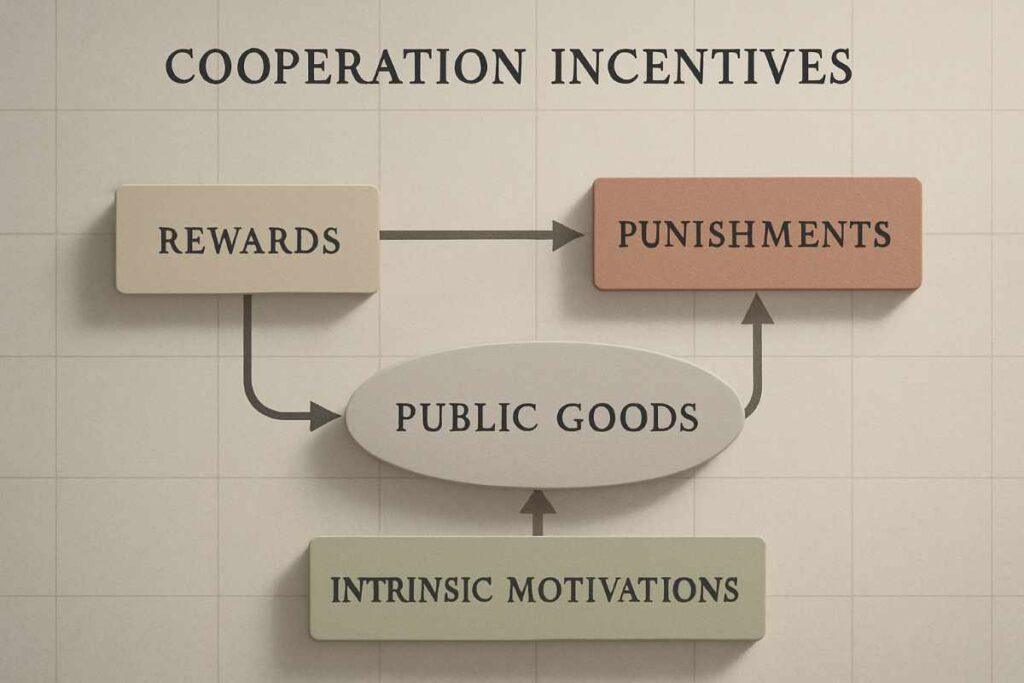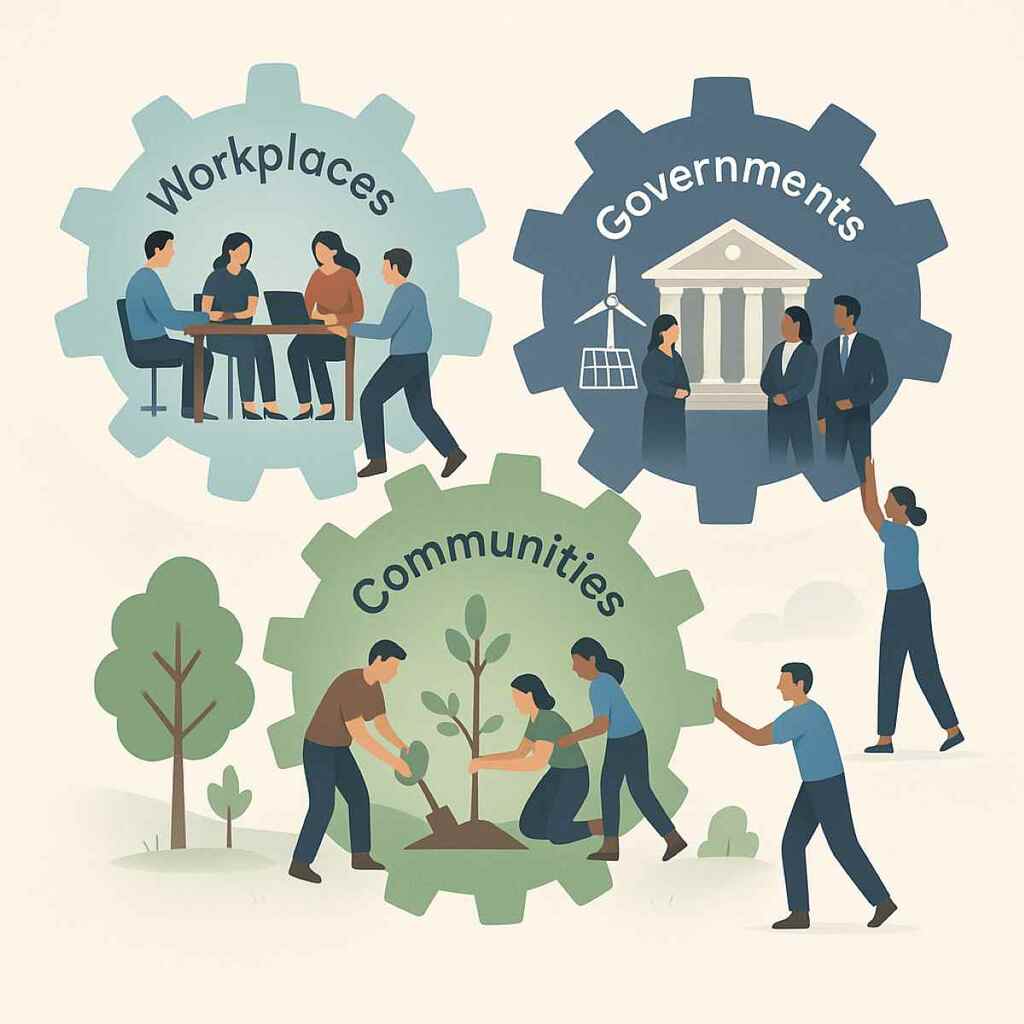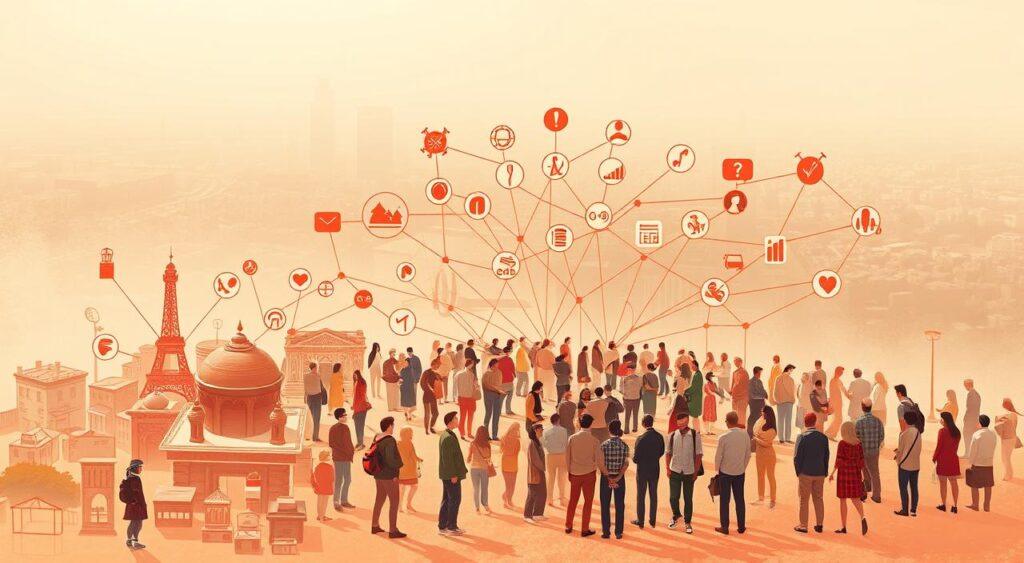The public goods mental model shows why important resources like clean air and digital infrastructure are available to everyone. It’s based on economics and game theory. It points out that while we all benefit, we often don’t want to contribute.
This leads to problems like the free rider problem and the tragedy of the commons. These issues happen when our own interests clash with the good of all. It’s a big challenge.
Think about climate change agreements or the security of the internet. They need everyone’s help, but some might not want to contribute. Research shows that when we don’t know who’s contributing, fewer people help out.
By understanding this model, we can create better systems. Systems that reward individual effort but also consider the community’s needs. It shows that sustainable cooperation is the key to shared success.
Key Takeaways
- Public goods mental model: Shared resources like clean air or parks are accessible to all, regardless of personal contributions
- Free-rider challenges emerge when people benefit without supporting maintenance costs
- Individual choices often clash with group needs in managing common assets
- Cooperative strategies outperform competition in preserving long-term value
- This model applies to modern issues like digital security and environmental protection
Introduction to the Public Goods Mental Model
Imagine watching fireworks light up the sky over a crowded park. You didn’t pay for the show, yet you enjoy every burst of color. This experience mirrors how public goods and shared resources operate – accessible to all, but dependent on someone else’s contribution and effort.
Economists developed this theory to explain why vital assets often lack proper funding. When everyone benefits equally, people tend to contribute less, assuming others will cover the costs. Streets, libraries, and disaster relief systems all face this paradox.
Consider a neighborhood upgrading playground equipment. Some families donate time and money, while others quietly enjoy the improvements. This tension between personal gain and group welfare defines the cooperation dilemma. Rational choices at the individual level – like avoiding taxes – can weaken community infrastructure over time.
Experimental studies reveal fascinating patterns. When participants fund shared projects anonymously, contributions drop by 40-60% compared to transparent systems. This “free riding” tendency shows why purely voluntary systems often fail. Yet when groups establish clear rules and mutual accountability, collaboration thrives.
Understanding these dynamics helps navigate team projects, environmental policies, and even household decisions. How might we redesign systems to align personal incentives with collective well-being? The answer lies in balancing participation with fair accountability measures.
Understanding the Public Goods Mental Model

What happens when your neighborhood votes on installing solar-powered streetlights? This scenario captures the heart of shared resource dynamics and the theory of public goods. At its core, every contribution creates ripple effects – your choice impacts others’ outcomes, highlighting the benefits of collective action among individuals.
Let’s break down the math. Suppose 10 households each receive $10. If everyone keeps their money, they each gain $10. But if all contribute $5 to a shared fund that triples in value, every household gets $15 ($5 kept + $15 from the pot). Collective gains beat personal hoarding – yet most people under-contribute.
Why? Your $5 costs you the full amount but only adds 50 cents to your share of the tripled pot. This imbalance creates a paradox: rational self-interest says “hold back,” while group logic demands “give more.” Experiments show anonymous contributions drop by half compared to transparent systems. Similar dynamics are studied in the Game Theory Mental Model which explores how strategic choices shape collective outcomes.
This tension explains why community projects often struggle. One family painting their house boosts curb appeal for all – but why shoulder the entire cost alone? The model reveals how personal sacrifices create widespread benefits, yet rarely feel worthwhile upfront.
How might we shift this pattern? Transparent tracking of contributions increases participation by 35% in controlled studies. When people see others investing, they’re more likely to join – turning “their problem” into “our solution.” What small act could you take today to strengthen shared resources tomorrow?
Key Concepts: Non-Excludability and Non-Rivalry
Picture a lighthouse guiding ships through stormy waters. Its beam helps every vessel nearby – whether they helped build it or not. This captures the essence of shared resources governed by two principles: non-excludability and non-rivalry, which are crucial for the group and individual contributions that lead to greater good and benefits for all.
Understanding these principles can help mitigate the punishment faced by those who contribute while others benefit without reciprocation, emphasizing the importance of collective endowment.
Non-excludability means once something exists, you can’t block access. Like sunlight warming a park bench, the resource serves all equally. Private companies often avoid funding these assets since free riders benefit as much as contributors.
Non-rivalry ensures one person’s use doesn’t shrink availability. Your morning jog through a city square doesn’t reduce paths for others. These traits combine to create systemic challenges – why invest if others reap rewards?
| Characteristic | Meaning | Real-World Example |
|---|---|---|
| Non-Excludable | No effective way to restrict access | National weather alerts |
| Non-Rivalrous | Usage doesn’t deplete supply | Radio broadcasts |
| Combined Effect | Requires collective funding | Flood control systems |
Street lighting shows both traits in action. You can’t stop neighbors from using illuminated sidewalks, and extra walkers don’t dim the bulbs. This explains why taxes fund such projects – voluntary payments rarely cover costs.
Recognizing these patterns helps design fair systems. What shared resource in your life operates this way? How might collective action strengthen it?
The Free Rider Problem and the Tragedy of the Commons

Picture a highway packed with commuters during rush hour. Each driver uses the road without considering maintenance costs – a perfect example of how shared systems collapse when individuals take but few give.
This dynamic lies at the heart of two critical dilemmas: free riding and the tragedy of the commons, reflecting trends in the structure of resource management and the potential loss of communal benefits.
Garrett Hardin’s 1968 essay revealed why rational choices often backfire. When herders added more cattle to communal grazing land, each gained personally while spreading environmental costs. The pasture eventually turned to dust – a collective disaster born from individual logic.
Modern parallels abound. Overfished oceans and crowded subway platforms follow the same pattern. Your decision to skip carpooling seems harmless, but multiplied by millions, it clogs cities with pollution. Why pay for what others will use freely? This mindset fuels underinvestment in vital resources.
Office coffee funds show the problem in miniature. Some colleagues refill the pot; others just pour cups. Without accountability, contributors feel exploited, and the system fails. Studies reveal groups using transparent tracking see 40% higher participation rates. This is where the Cooperation Incentives Mental Model highlights strategies to balance fairness and long-term group success.
Breaking this cycle requires smart strategies. Fishing quotas, congestion pricing, and carbon credits all realign personal gains with group needs. What daily choices could you adjust to protect shared systems?
Historical Perspectives: Garrett Hardin and Modern Climate Change
What do 1960s cattle pastures have to do with today’s climate crisis? Garrett Hardin’s seminal 1968 essay first exposed how rational choices can destroy shared systems. His study of overgrazed communal lands revealed a pattern now playing out globally – individual gains eroding collective survival.
Hardin’s research showed herders adding “just one more cow” to communal fields. Each gained personally while spreading environmental costs. This logic now drives fossil fuel use – nations extract resources for immediate gain, ignoring long-term climate impacts.
In 2022, governments spent $1 trillion subsidizing coal, oil, and gas – enough to fund global renewable energy transition twice over. This contradiction between environmental pledges and financial decisions mirrors Hardin’s original paradox. Why pay more today when others might benefit tomorrow?
| Era | Challenge | Response |
|---|---|---|
| 1960s | Local grazing collapse | Hardin’s “tragedy” framework |
| 2020s | Global climate breakdown | Paris Agreement mechanisms |
| Future | Cross-border cooperation | Carbon credit evolution |
Modern research builds on Hardin’s work through climate models. These show how emission cuts require binding agreements, not goodwill. When the U.S. reduced coal use by 55% since 2005, global emissions kept rising – proof that isolated actions fail.
What lessons can we apply? Transparent tracking of national commitments increased compliance by 22% in 2023. Like herders needing pasture rules, countries thrive when accountability replaces ambiguity. How might your community mirror these global patterns?
Real-World Applications: Clean Air, Public Parks, and National Defense

Consider your last visit to a city park. You might’ve noticed families picnicking, joggers on trails, and kids climbing playground equipment – all enjoying the space without diminishing its value. This harmony reveals how shared resources thrive when managed collectively, showcasing the role of individuals in this strategy.
Clean air operates similarly. No one can charge you for breathing, and your exhalations don’t reduce oxygen levels for others. Yet pollution control requires coordinated efforts – a challenge when free riders benefit without contributing. Environmental regulations address this by mandating emission limits, transforming personal responsibility into collective gain.
| Resource | Key Features | Funding Mechanism |
|---|---|---|
| National Defense | Protects all citizens equally | Tax-based systems |
| Public Parks | Non-rivalrous enjoyment | Municipal budgets |
| Legal Systems | Universal access to justice | Government allocations |
Workplace teams often mirror these dynamics. When colleagues collaborate on shared projects, individual efforts lift entire groups. Yet without clear structures, some may withhold input while reaping rewards. Transparent task tracking often solves this – much like how park maintenance relies on scheduled upkeep rather than random goodwill.
What shared spaces or systems in your life depend on collective participation? How might small, consistent contributions strengthen them?
Mechanics of the Public Goods Game in Experimental Economics
Imagine sitting in a lab with $10 to split between yourself and a shared project. This scenario lies at the core of experimental studies testing human cooperation. Researchers use token-based games to reveal why we sometimes support group goals – and other times withhold our contributions.
Public Goods Mental Model: Game Theory and Nash Equilibrium
In these experiments, participants receive equal tokens to keep or invest in a collective pot. The pot grows through a multiplier – say 1.5x – before equal division. Game theory predicts zero investments: keeping all tokens maximizes personal payoffs if others contribute. This “Nash equilibrium” shows rational self-interest clashing with group benefit.
Yet real-world results differ. Initial rounds typically see 40-60% token investments. One study found groups contributing 51% of endowments when anonymous – far above the expected zero. This gap between theory and practice reveals our innate pull toward cooperation, even without guarantees.
Iterated Games and Behavioral Insights
When games repeat over multiple rounds, contributions often decline. Seeing others invest less triggers defensive withdrawals – like cutting charitable donations after hearing about tax evasion. Researchers call this “conditional cooperation”: we mirror others’ strategies rather than stick to ideals.
| Round | Average Contribution | Group Trust Level |
|---|---|---|
| 1 | 58% | High |
| 5 | 32% | Moderate |
| 10 | 19% | Low |
Transparency changes outcomes dramatically. Groups allowing contribution visibility maintained 74% higher investments over time. This mirrors workplace teams thriving with open task boards versus hidden workloads. How might clear communication strengthen your next group effort?
Incentives, Punishments, and Rewards to Foster Cooperation

Teamwork thrives when contributions matter. Groups often struggle to balance fairness with results – how do we encourage participation while deterring freeloading?
Research reveals surprising truths about human behavior in shared efforts, highlighting the dilemma of cooperation. Various examples show that the application of sanctions can significantly influence the effect of contributions on group dynamics.
Punishment Mechanisms and Free Riding
Imagine a neighborhood watch program where rule-breakers face fines. This mirrors experimental findings: allowing groups to penalize free riders boosts cooperation by 23%. Participants willingly pay to punish, even when it costs them personally. One Brown University experiment study showed contributions rising 40% when penalty options existed.
But there’s a catch. Enforcement consumes resources – like police patrols or monitoring systems. Early stages often see reduced payoffs as groups establish norms. Over time, these strategies create lasting change. Traffic ticket systems work similarly: fines modify behavior more effectively than goodwill campaigns.
Reward Strategies in Group Contributions
Positive reinforcement has limits. Recognizing top contributors – through bonuses or public praise – temporarily lifts participation. Yet without consequences for slackers, efforts fade. A 2021 meta-analysis found reward-only systems saw 19% lower sustained contributions versus punishment-reward hybrids.
Think of workplace teams: annual bonuses motivate, but consistent accountability drives daily excellence. The most successful groups blend both approaches. Teachers use this balance – gold stars for effort, and redos for missed assignments.
What happens when we apply these lessons? Communities with clear rules and recognition programs report 32% higher volunteer retention. The effect compounds over time, turning fragile cooperation into durable success. How might you redesign incentives in your next group project?
Mathematical Framework and Economic Modeling
Think about splitting a dinner bill with friends. Your choice to chip in extra affects everyone’s final cost – similar to how economic models quantify shared resource decisions. These frameworks reveal why rational choices often clash with group needs.
The core equation looks simple: Your payoff = (Personal funds kept) + (Group pot × multiplier). Imagine keeping $8 while donating $2 to a project that triples in value. If four others do the same, you gain $8 + ($10 × 3)/5 = $14 total. But if you keep all $10 while others contribute, you profit more – creating tension between individual and collective gains.
Researchers use these interactions to predict real-world behavior. Tax policies, for example, balance personal savings against community benefits like roads and schools. The math shows optimal contributions occur when marginal personal cost equals marginal group benefit – a tipping point few reach voluntarily.
Why does this matter? These models help design systems where individual incentives align with shared good. Carbon pricing schemes apply this logic – making polluters internalize environmental costs. Similar principles guide workplace bonus structures and open-source software funding.
What daily choices could you reframe using this lens? How might small adjustments create better results for all?
Practical Frameworks for Applying the Public Goods Mental Model

The public goods mental model is more than just theory. It’s about creating systems that help us work together. By making sure everyone’s interests match the group’s goals, we avoid freeloaders. This way, everyone contributes, and resources grow for all.
Here are three domains where this model has proven essential:
| Domain | Strategies | Impact |
| Workplaces | Open-source knowledge libraries, transparent task boards, team-based bonuses | Encourages consistent contributions and prevents uneven workloads |
| Communities | Rotating volunteer schedules, shared funding pools, recognition programs | Maintains parks, playgrounds, and local safety initiatives |
| Governments | Carbon credits, congestion pricing, universal healthcare systems | Aligns self-interest with the common good for long-term stability |
These frameworks show that fairness and accountability lead to lasting cooperation. What small changes can you make today to improve public goods in your world?
Conclusion
The public goods mental model offers a clear lens for understanding why cooperation is essential in sustaining resources that serve everyone. From neighborhood parks to global climate agreements, the health of public goods depends on individuals choosing to contribute, even when personal gain may seem minimal.
Recognizing the dangers of the free rider problem and the tragedy of the commons allows us to design systems that align self-interest with collective benefit.
Modern strategies such as carbon credits, transparent contribution tracking, and community incentive programs show how effective frameworks can transform fragile cooperation into lasting progress.
By applying these lessons, we not only protect essential resources but also strengthen trust and accountability across teams, communities, and nations.
To deepen your understanding, also explore related models such as the Tragedy of the Commons Mental Model. Also, look into the Cooperation Incentives Mental Model and the Game Theory Mental Model. These models offer practical insights for creating systems that rely on collective responsibility.


